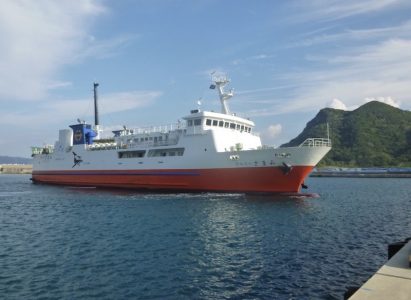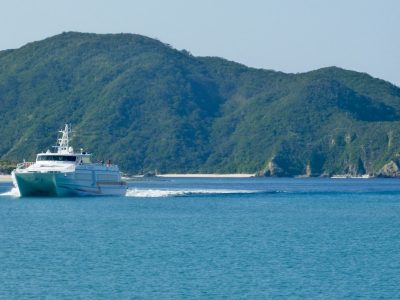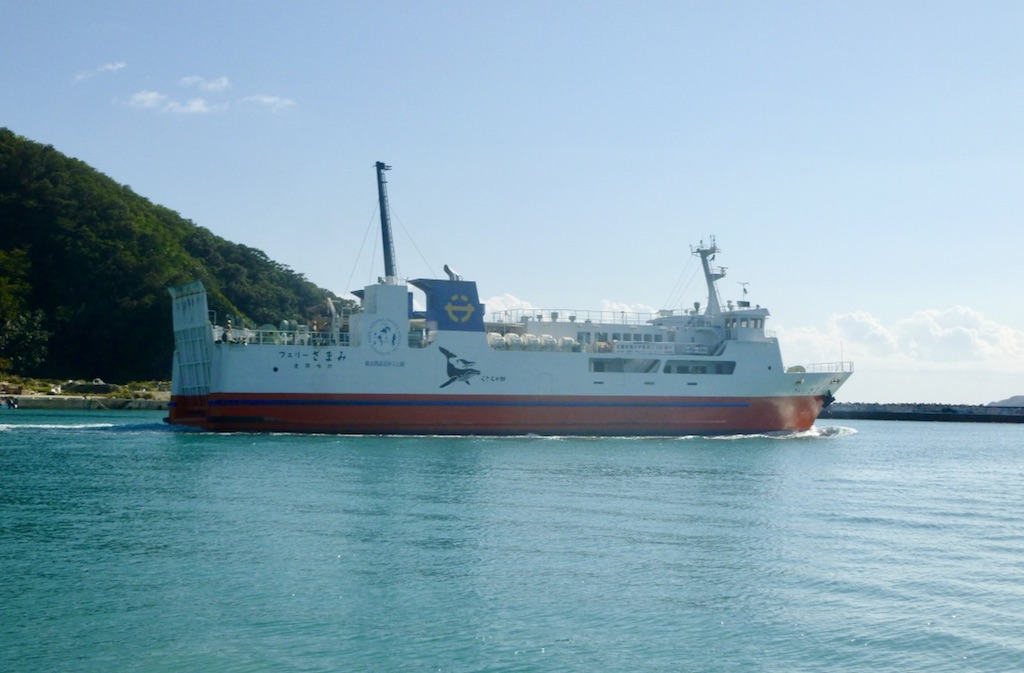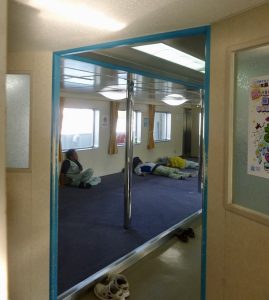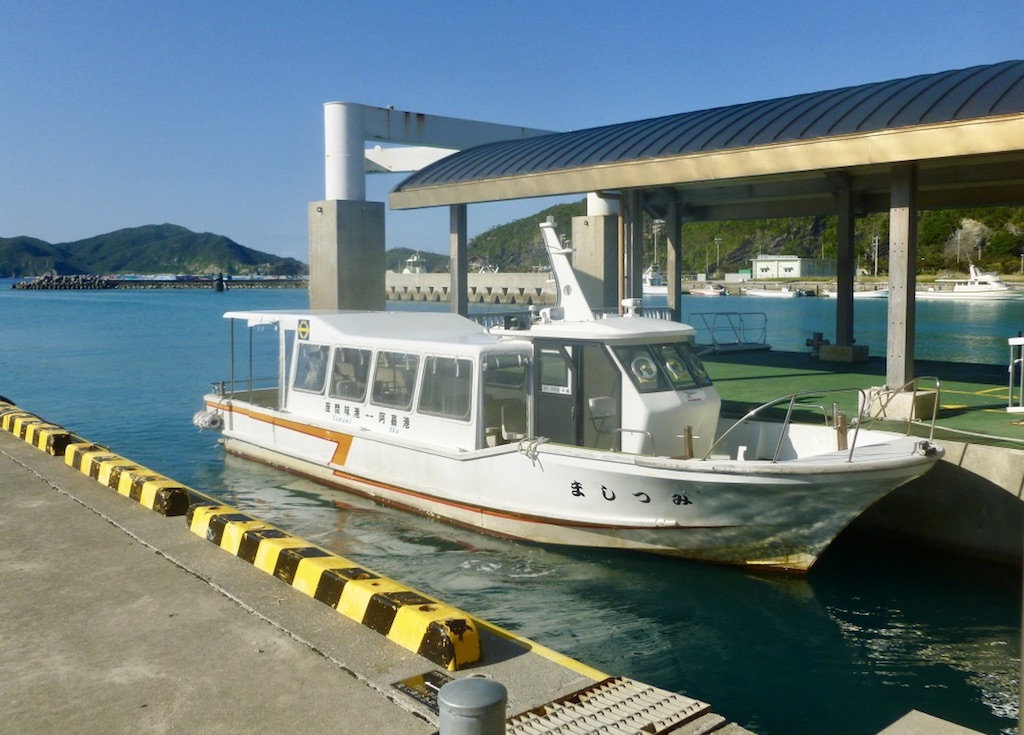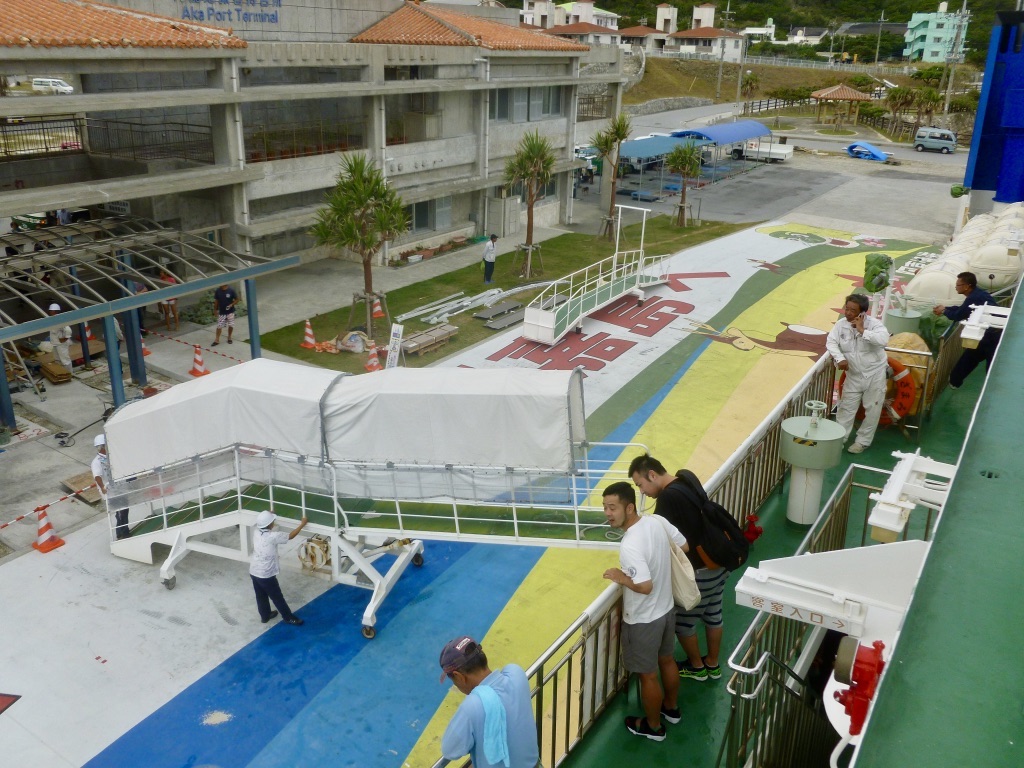
Mural on the quay at Aka, viewed from the top deck of Ferry Zamami: how would this go down at Brodick, Craignure or Stornoway?
More accustomed to crossing the Minch on Hebrides and Loch Seaforth, Colin Tucker recently sampled some of the inter-island ferries in Japan, where he found echoes of and contrasts with the CalMac experience.
We were all taught in our school geography that Japan consists of four main islands. What we did not learn is that there are many smaller islands, and that some of these, the Ryuku Archipelago, stretch south almost to the Tropic of Cancer, and are nearer to Taiwan than to Tokyo. Where there are islands, there are almost bound to be ferries, and this, indeed, is the case with some of the southernmost of the chain.
Okinawa is perhaps better known as the site of one of the battles fought in the Second World War, but today it is the hub for ferries linking its main port of Naha with a number of islands. Regular services operate to Kume and Aguni Islands, with crossing times of four and two hours respectively. Nearer are the Kerama Islands, served by both a high speed boat and a conventional ferry. It is to these islands that we travelled, but it was also possible to watch ships leaving Naha for the other destinations.
Our journey to Aka and Zamami was made on Ferry Zamami, which makes one round trip each day from Tomari, the port in Naha. The faster passenger-only vessel, Queen Zamami 3, runs twice daily, and makes three round trips during the busy summer months. The website warns that the sailings may be cancelled due to high waves, over three metres for the fast ferry and over four for Ferry Zamami.
This happens ‘sporadically throughout the year, though more so during the typhoon season’, and you are recommended to ‘check the weather before your trip as there is a possibility you could be stranded on Zamami if a typhoon blows in.’ This did not happen while we were there, but a year earlier our son had an extended stay there.
Our sailing was scheduled to depart at 1000, but we were there early as we were not sure of the booking system. It was like CalMac, with tickets being bought before boarding, but there was no need to be there 30 minutes before sailing. There was time to wander round the quay, and watch a few cars and more cargo being loaded on pallets by a fork lift truck.
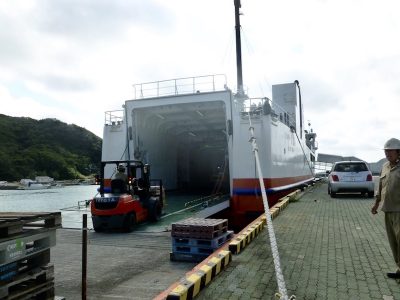
Unloading cargo at Zamami, where Ferry Zamami sat for a leisurely three hours before returning via Aka to Naha
Ferry Zamami is of modest size — smaller, I think, than the Clyde ‘streakers.’ She is not a drive-on-drive-off ship, having only a stern ramp leading to a covered car/cargo deck. I call it this because the two islands she serves are so small that very few cars are carried.
Forward of the car deck is passenger accommodation – I hesitate to call it a lounge, as there is simply an area with no seats, the Japanese being quite used to either sitting or lying on the deck, after having first removed their shoes. A conventional lounge is at the forward end of the next deck, the after part of which is given over to an open deck, part of which contains a few rows of CalMac-like seating.
Two side decks run outside the lounge, and from these it is possible to see into the wheelhouse. Steps also lead up from here to another open deck, this one without seating. It was here that I found a notice stating ‘Do not take off clothes’, which we thought unlikely to be seen on any CalMac ferry.
The crossing to Aka takes 90 minutes. En route we passed Queen Zamami 3 returning to Naha, having left there earlier at 0900 and taking only just over two hours to complete the round trip. Arriving at Aka we swept into a small harbour and swung round to present the stern to a wide slipway. It was all very similar to arriving at a Hebridean island, until we noticed the ‘mural’ and ‘welcome to Aka’ painted on the quayside – another tip for CalMac?
A covered gangway was hauled alongside, and a few locals and trippers descended, while we watched two or three pallets of cargo emerging from the stern.
Then we were off again, this time on a short 15-minute crossing to our destination at Zamami. The two islands face each other across a narrow sound, a bit like Vatersay and Barra before the causeway, and indeed the two islands are similar in size to their Sottish counterparts. Zamami also has an iconic feature in the bay, but instead of Kisimul Castle we saw a sculpture of a shark. Once landed we watched more cargo being unloaded, after which Ferry Zamami sat for a leisurely three hours in the sub-tropical heat before returning via Aka to Naha.
There is also a small ferry, described as a speedboat, which runs four times a day between Zamami and Aka. The crossing takes the same time as by the larger ferry, and is operated by a small passenger-only vessel, Mitsu Shima. We made use of this service after a couple of days on Zamami.
It seemed a very casual service, the ferry being operated by a crew of one, who did everything from piloting the vessel to tying up and checking tickets. But everything on the islands was also very laid back, reminding us of old Hebridean ways, even if the temperature was in the upper twenties in November.

The manoeuvres are the same as anywhere on the west of Scotland, but the setting here is Japan: Ferry Zamami berths at Aka in preparation for offloading her passengers and cargo
All photos © Colin Tucker
MORE BY COLIN TUCKER:
Crossing the Minch — Variations on a Theme
The future of the Outer Hebrides, 40 years ago
Gleanings from the ‘Highland News’
Colin Tucker’s widely admired book Steamers to Stornoway is available in the CRSC Shop.
Join CRSC now for £10 and receive all the benefits — discounted prices, exclusive magazines, special events, meetings, cruises.
To receive occasional newsletters from CRSC by email, subscribe to our mailing list.
Published on 19 October 2018












